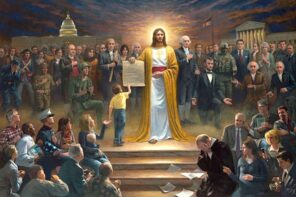On April 4, 2008, we solemnly observe the fortieth anniversary of the assassination of Martin Luther King Jr. We are invited to remember who King was: a prophetic Christian, a preacher who preached his most important sermons through the symbolic action of the protest march—what his colleague Rabbi Abraham Joshua Heschel called praying with your feet.
Invariably, during discussions of racial relations (usually construed as relations between black and white people) or when civil rights are discussed, the question arises “What would Martin Luther King Jr. say if he were alive?” Or, “What would he think?” Such questions, I submit, are a bad way of remembering King, of paying homage to the work that he did and to the sacrifices that he made. Such questions (as the Million Man, Million Woman, Jena 6, and Katrina marches show) inhibit our ability to create strategies and tactics appropriate to our circumstances. King may be our inspiration, but only rarely can he be our guide.
We fail to remember King properly when we summon him from the grave and solicit his advice and authority on issues we face, as if his insight, unlike ours, is flawless; as if he were a timeless font of wisdom. With their mind-numbing repetitions of the “I Have a Dream” speech, King Day celebrations have become pure saccharine, a soul-decaying sweet. Reverend King was a human actor, like you and me; more extraordinary perhaps, but ordinary just the same. Like you and me, he was buffeted by circumstances he did not choose. He made the best choices that he could (most of the time) given the circumstances, acting the way everyone acts: from compulsion, from character and disposition, from habits that had been cultivated over a lifetime. The reasons came later, after the fact, when the heat of the moment had passed, and in calm repose he could reflect and give an account, retrospectively, of why he did what he did. This is the nature of decision-making, especially within contentious ethical-political struggles such as the civil rights movement.
King was a preacher who lived his Christian creed through the black freedom struggle. In the tradition of Amos, one of his favorite 8th-century prophets, King denounced American “principalities and powers” for oppressing the poor and the weak, for buying “the poor for silver, and the needy for a pair of shoes.” This is powerful inspiration for those of us who follow King. But he cannot be our guide because our circumstances are different. The successes, uneven results, and failures of strategy and tactics that the King-led movement experienced are now part of the circumstances under which we must choose and act. For this profound reason alone, what worked for King and his “generation” is unlikely to work for ours. Their success has created new problems for us and provided new insights regarding old problems. Our challenges and opportunities are different.
An index of these challenges and opportunities is the transformation of black identity. Once upon a time we paid little attention to differences among black people. In the nighttime of white supremacy, all we could see was blackness. Gender differences were invisible as were differences of religion, culture, sexual orientation, region, politics, and class. White supremacy was so intense and omnipresent that differences that have always characterized who black people are seemed trivial, unreal, a plot against black solidarity. When these differences were not forgotten or denied, they were often construed as signs of racial treason.
A sure sign of the success of the civil rights movement is the irruption of these suppressed differences. Only rarely and under specific circumstances can one now speak, without considerable qualification, about what black people want. Black people want many different and incompatible things. The interests and desires of black people can no longer be described in a single, non-contradictory voice. Our success has made it more difficult for us to say “we.” This is a good, bad, and complicated thing. Good, because white supremacy does not circumscribe the lives of black people as intensely as it once did; bad, because it makes it more difficult to contest residual forms of white supremacy; complicated, because ambiguity and ambivalence are the predictable results of increased freedom and opportunity.
Indeed, racism, which is the ideological expression of white supremacy, has become, paradoxically, both weaker and more sophisticated. Racism is now articulated in complex and subtle ways that track class and gender differences, which makes it harder to detect and fight. Class, race, and gender mystify each other, thus obscuring a complex relation among them. These realities have led some conservative commentators to speak of the “end of racism.”
Racism has not ended. The legacy of slavery and Jim Crow, a pathological animosity toward black people, has not been overcome. But the paradox of declining significance and increasing sophistication makes it harder for those of us who insist that the residual power of white supremacy is more than vestigial.
The old language of “we” cannot account for the complexities of our current situation, especially if we see racism as the most important explanation for the state of black America. For a significant minority of the black population who are well-educated, have good-paying, high-status jobs, things have never been better. The sky is the limit. And some of them, like Barack Obama, are touching the sky. In contrast, for roughly one-third of the population, things are bad and getting worse: they are poorly educated, unemployed, underemployed, or trapped in low-paying and low-status jobs. This segment of the black population is falling, and with the globalization of labor markets there is no bottom in sight. The simple language of white racism and civil rights cannot explain or remedy this ugly reality.
Unfortunately, some black elites, those among the upper one third, exhibit a kind of “survivor’s guilt” when they consider their privilege in light of the deprivation of the bottom third. Black elites have a vested interest in mystifying the nature of that deprivation since it reveals their common class interests if not complicities with white elites. Thus they exaggerate racism as an explanation and minimize a domestic and international division of labor that creates winners and losers across racial lines. Thus they are tempted to address these complexities, as Reverend Wright did, as if nothing has changed since Montgomery in 1955 and Birmingham in 1963. But things have changed and are more complicated now. For these reasons, King may be our inspiration, but he cannot be our guide.
The King-led civil rights marches appealed to the residual normativity of Christian fraternity and to the implicit universalism, though travestied by slavery, of the Declaration of Independence. These marches were morality plays that created a visually stark and conceptually simple drama in which black people (and a few others) presented their bodies to be spat on, beaten, and bitten. They presented themselves as a living sacrifice to God and to the cause of civil rights. This stark, simple drama was designed to capture the attention of the national media and of white people of goodwill.
As pictures of nonviolent protestors being brutalized by the forces of white supremacy played across television screens in America and around the world, the moral conscience of the nation was challenged. But its cold war anxieties were provoked: Was the civil rights movement a communist conspiracy? What would the rest of the world think when we preached liberty and justice abroad while denying them at home? Sometimes this drama changed what was in people’s heads and in a few cases it changed what was in people’s hearts. As a result, every “legal” impediment to the civil rights of black people eventually fell.
The appeals that characterized the King-led marches work best and perhaps only work where the issues are literally black and white. Even then they worked only with great difficulty. Civil rights—with its images of police dogs and fire hoses, tear gas and nightsticks, “white only” and “colored only” facilities, humble black protagonists and arrogant white antagonists, black Christians and white sinners—lent itself easily, relatively speaking, to the theatrical character, the dramaturgy of the march. But the march loses its dramatic power where the issues are more complicated and are painted in subtle shades of gray; a gray zone that sometimes produces red and white-hot reactions, especially among the white working class. This explains the current reaction to affirmative action.
But Barack Obama is only partially correct when he construes black anger and white working-class resentment as equivalent. That resentment has always been misdirected toward black people rather than toward white elites. Working-class whites—this a truth Obama could not speak—took comfort in their “superior” whiteness, even as white elites had the same boot on their necks as on the necks of black people. This compensatory privilege of looking down their noses at an even more wretched black people was the “wages of whiteness”—a “psychological wage,” as W. E. B. Du Bois called it that working class whites earn by construing their interests in racial rather than class terms, by attributing their economic insecurity to black people rather than to white elites and to the system they made. This same misdirected resentment—misperceiving black people as responsible for a set of socio-economic circumstances that were created by white elites (politicians, bankers, and captains of industry), circumstances that often impoverished the white working class—fueled the southern strategy in presidential elections and created Reagan democrats.
Given this history, marches may be an effective tactic for dramatizing the denial of basic civil rights; issues such as voting rights, public accommodation, and the white violence that accompanied efforts to secure them; these can be painted starkly, in black and white. But the complex issues that motivate opposition to affirmative action and the “reparations agenda” do not lend themselves effectively to political theater. The residues of white supremacy and problems faced by the poor and oppressed regardless of race require a kind of work that is more intensely conceptual and policy-driven than the passion-play-like high drama of civil rights-style marches. The pragmatic realities of the problems themselves and the realities of the present historical conjuncture demand this kind of work.
Black bodies in public spaces are still subversive, but not in the ways that made the civil rights marches so effective. Black insurgents into public/white spaces were often depicted sympathetically and cast in a noble light. This literal and symbolic transgression of public space sometimes produced forms of white introspection and action that were politically and ethically progressive. But clearly things have changed. Black bodies in public spaces no longer signify the unjust denial of basic civil rights; rather, they signify “unjust” demands for preferential rights called affirmative action and reparations. Gone are images of white violence and black victims.
Black bodies have reassumed their older meaning within the white imagination as the most powerful symbol of predatory violence itself. These bodies provoke fear rather than sympathy: the kind of fear that makes Rodney King and Amadou Diallo-like incidents “reasonable” and leads obtuse journalists and pundits to label the Reverend Jeremiah Wright as a “racist bigot.” On this issue, the punditocracy, especially former Congresswoman Geraldine Ferraro, have turned the truth upside down. Fear can make people say the darndest things. Freud and his entire Vienna circle of depth psychologists (Carl Jung, Alfred Adler, and Otto Rank among others) would not have the intellectual wherewithal to analyze the kind of twisted logic—rooted in a long history of racist assaults and denial of responsibility—that produces the kind of perverse inversions that resonate so powerfully in the comments of Ferraro. But I digress. Or do I?
Like Ferraro’s obsession with black people who are out to get her because she is white, a notion that inverts the historical reality of white people oppressing black people (psychologists call this projection), our obsession with King makes it more difficult to address the complex realities that produced figures as different as Rodney King, Barack Obama, and Reverend Wright. Indeed, King’s words are now being used against these men and against those of us who share much of his vision. King has been kidnapped and has become the puppet for a right-wing ventriloquist. He was abducted right from under our noses because of our failure to remember him the right way.
Because of this failure, King’s metaphor, “the content of their character,” has been turned against him. King’s language has been seized by Shelby Steele and by the right wing, who would fashion themselves as his legitimate heirs. In fairness to Steele, I should say that his position is not quite that of the rabidly anti-black right. But to the extent that he and they have been successful, their success rests on our failure to define King’s metaphor in light of current circumstances: to question its usefulness, to determine whether it is a Trojan horse within King’s “beloved community;” that is, whether the principle of “colorblindness” undermines other values that King cherished. We have failed to ask whether King was simply wrong, not at the time he spoke enthusiastically for the principle of colorblindness, but retrospectively. But we can ask this question only if we take King as our inspiration, not as our guide.
King said “unpatriotic” things about America’s militaristic, bloodthirsty, and racist foreign policy (“The greatest purveyor of violence in the world today [is] my own government.”) that makes the Reverend Jeremiah Wright sound like that elderly, goatee-wearing, and uncritical booster of American patriotism named “Uncle Sam.” Toward the end of his life, he was not intimidated by those who questioned his patriotism. He realized that “patriotism” is a mistake, an ethical lapse of judgment; indeed, it is the last refuge of scoundrels. When faced with the choice between the “cross” and the “flag,” King chose the cross. That was his way of saying “God damn America.” And there was much that deserved damnation. In the name of God, King condemned America for killing the poor of Vietnam and neglecting the poor at home. Romans crucified Jews and Christians; Americans carpetbombed, mined, and napalmed the Buddhists of Vietnam. (By the way, unlike Jesus, King and Wright do not call their critics “vipers” and the “children of Satan.” Jesus was often nice, but in his demonizing mood he could be quite nasty.) So I say to you dear Geraldine Ferraro, if Wright is an unpatriotic, racist, bigot, then so was King.
Remembering King the right way does not mean following him slavishly. We pay King the proper respect when we stop thinking nostalgically about what King did, stop asking the question “What would King think?” and begin to do the work that only we can do. To do otherwise, to march as a reflex action, is to behave like a chicken with its head cut off; headless chickens run, and sometimes march, but they never think. Thus to march because we haven’t thought through the appropriateness of the tactic in our complex circumstances is to repeat a tragic history—this time as farce.





